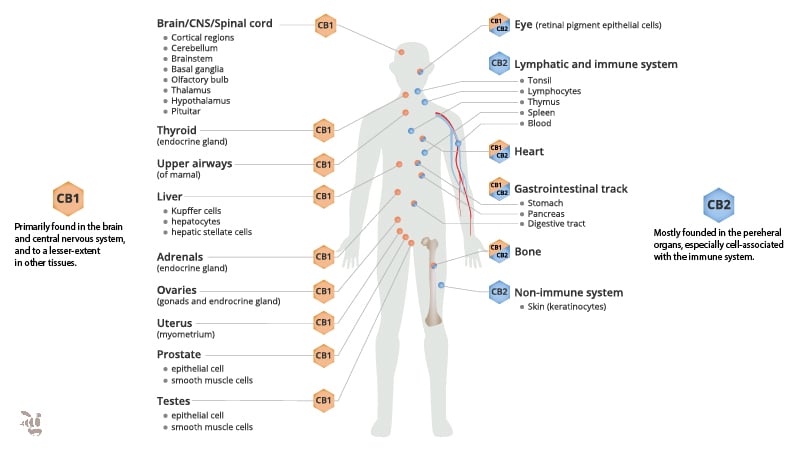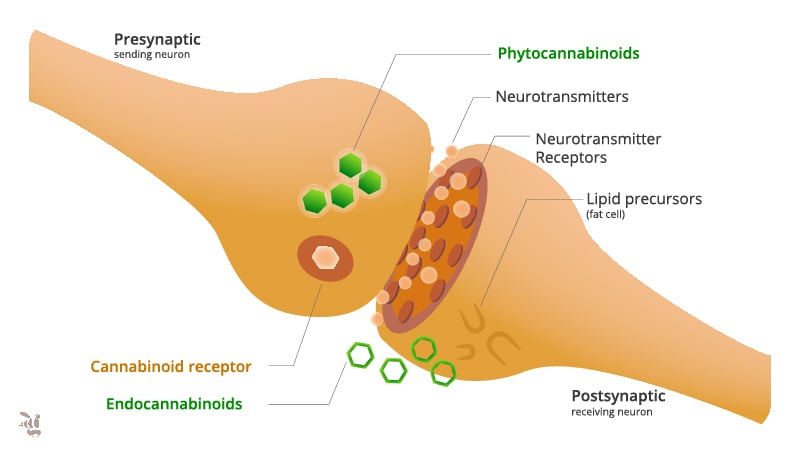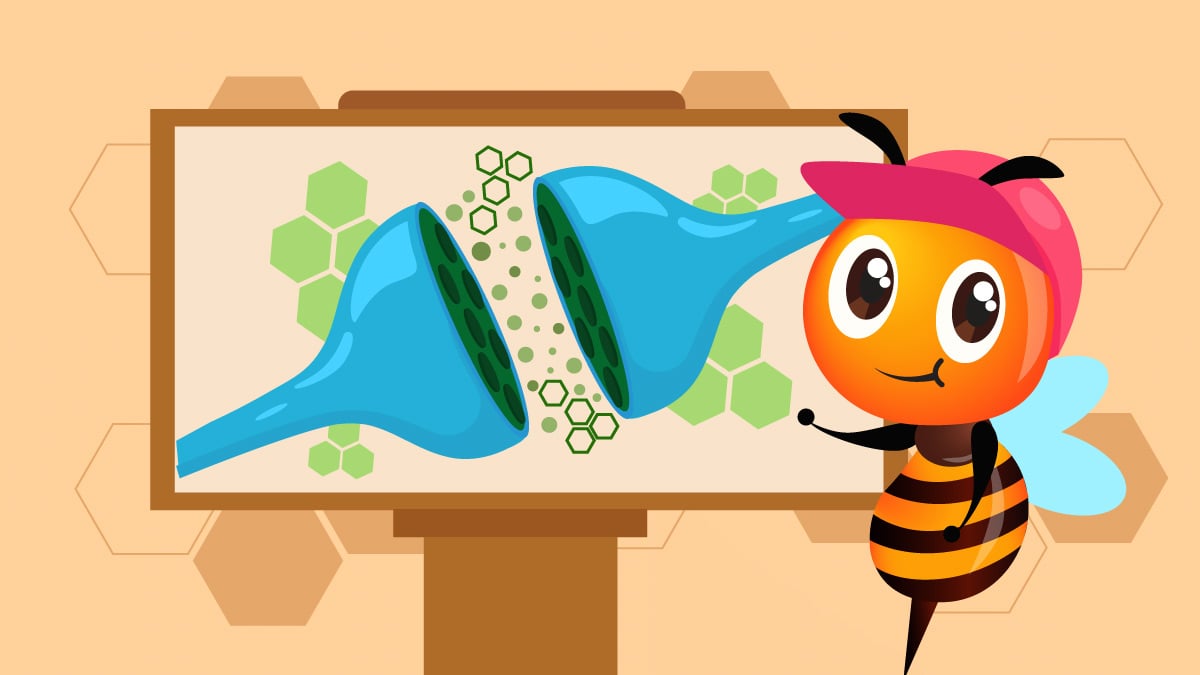The discovery of cannabinoids such as CBD and THC has spurred the research into the benefits of these molecules for the human body, and the way they manifest these effects. After discovering a vast network of cellular receptors known as the endocannabinoid system (ECS), the missing puzzle was finally found.
This groundbreaking finding not only helped scientists figure out how cannabinoids work, but it also shed light on a sophisticated physiological system that is arguably the most important neurochemical network in humans.
Today, we’ve prepared a short guide to the endocannabinoid system for everyone who’d like to understand how CBD and THC produce their effects on the body.
Let’s highlight the main components of the ECS first.
The Components of the Endocannabinoid System
The endocannabinoid system consists of three key elements: endocannabinoids, receptors, and enzymes.
Endocannabinoids
These compounds are naturally produced by the ECS and synthesized in the body to signal the receptors of the ECS. Endo comes from Greek and means “within,” whereby cannabinoids refer to the molecules that activate these receptors. The two major endocannabinoids in the body are 2-AG and anandamide (1).
Cannabinoid Receptors (CB1 and CB2)
The endocannabinoid system has two types of receptors: CB1 and CB2. These binding sites are present in all organ systems and on many cell types throughout the body. Different cannabinoids can activate, inhibit, or modulate the activity of the cannabinoid receptors. This is true for both endocannabinoids, phytocannabinoids (those from plants), and synthetic cannabinoids made in a laboratory. Researchers also believe TRPV1 (transient receptor potential vanilloid one) to be part of the ECS, as it works as a binding site for CBD, THC, and anandamide.
Enzymes
Enzymes are proteins that break down certain chemicals in the body in order to catalyze chemical reactions. The endocannabinoid system is made of enzymes that both build and metabolize cannabinoids. One of the main enzymes in the ECS, fatty acid amidohydrolase (FAAH) breaks down anandamide.
What Are Cannabinoid Receptors and What They Do

Cannabinoid receptors are an essential part of the endocannabinoid system. As they receive messages from endocannabinoids, transferring them between cells, and from the outside of cells to the inside, they allow these neurotransmitters to manifest their effects on the body and brain.
Where Are CB1 Receptors Located?
CB1 receptors are mostly found throughout the brain and the nervous system, although they can be found in many other areas as well. So far, researchers have discovered CB1 receptors in the following regions of body areas:
- Brain
- Fat cells
- Gastrointestinal tract
- Liver
- Pancreas
- Reproductive organs
- Skeletal muscles
- Spinal cord
Where Are CB2 Receptors Located?
Although less-studied than CB1 receptors, CB2 receptors appear in fewer regions in the body. They are primarily found in the immune system but also in the skin. Researchers have identified CB2 receptors in:
- Bone
- Fat cells
- Gastrointestinal tract
- Immune system
- Liver
- Reproductive organs
Why do People Have Cannabinoid Receptors?
Cannabinoid receptors occur in the membrane of many cell types throughout the body. It consists of two spaces — extracellular (outside of the cell) and intracellular (inside). When a cannabinoid binds to a cannabinoid receptor, it sends a signal to the inside of the cell that changes the way it functions. The place of activation of the receptor often indicates what functions it affects.
Cannabinoid receptors work as the middleman between the extracellular space and the inside of the cell. Upon activation, cannabinoid receptors cause the cell to change its activity and lead to a collective shift towards homeostasis — a state of internal balance.
What is the Role of the Endocannabinoid System?
Cannabis researchers have defined the endocannabinoid system as a homeostatic regulator (2). In other words, the ECS ensures that other processes are running without any disturbances. Neurons use the synaptic space to send cannabinoids backward to receptors to manage what molecule they want to receive (3).
A classic example of homeostasis is body temperature. If it spikes too high or drops too low, physical functions don’t operate properly. Our body constantly tries to keep the safe range of 36-37 C.
All of our physiological systems function in a constant state of balance, and endocannabinoids help to regulate this state as necessary. The endocannabinoid system demonstrates modulatory effects on the following systems (4):
- Central and peripheral nervous systems
- Endocrine system
- Immune system
- Metabolism
How Does CBD Interact with the Endocannabinoid System?

Phytocannabinoids in CBD oil have different mechanisms of interacting in the endocannabinoid system. CBD has a low binding affinity for both CB1 and CB2 receptors. The truth is, CBD works to inhibit CB1 receptors when administered along with low doses of THC (5). For this reason, CBD doesn’t have intoxicating properties — it won’t get you high.
In addition to that, CBD binds to the TRPV1 receptor, a site partially engaged in the signaling of the endocannabinoid system. Activating this receptor influences different physiological processes depending on the trigger.
When you take CBD oil, the CBD also indirectly stimulates CB1 and CB2 receptors by increasing the concentration of anandamide. That’s because the cannabinoid inhibits the enzyme FAAH, which would otherwise break down anandamide. This feature makes CBD anandamide reuptake inhibitor.
As the research into the health benefits of CBD expands, breeders are investing large amounts of time developing CBD-rich cannabis strains to meet consumer demand.
High concentrations of CBD can also be found in the flowers of industrial hemp plants, the non-psychoactive cousin of marijuana.
How Does THC Interact with the Endocannabinoid System?
THC is strikingly similar to anandamide in its molecular structure, which enables it to bind to and activate both CB1 and CB2 receptors.
Until recently, breeders have been focused on creating THC-rich strains due to the signature marijuana high it produces. This altered state of mind is achieved by THC’s affinity for the CB1 receptors in the brain, leading to an increase in dopamine levels, a euphoric mood, increased appetite, and deep relaxation on top of other physiological changes.
However, THC and anandamide only partially stimulate the CB1 receptor. Researchers have also invented a synthetic form of THC that activates the full site, but often to an undesirable degree that triggers paranoia and panic attacks. THC is also a partial agonist of the CB2 receptor.
How to Maintain the Proper Functioning of the Endocannabinoid System
The endocannabinoid system is quintessential for humans to maintain physiological balance. However, sometimes the functioning of the endocannabinoid system can be compromised by a variety of factors. Researchers suggest that every person has an optimal “endocannabinoid tone,” a term that refers to the sufficient volume of cannabinoids produced and circulated in the body.
Insufficient levels of cannabinoids might trigger a condition known as clinical endocannabinoid deficiency (CECD) (6). According to researchers, clinical endocannabinoid deficiency may be the underlying cause of migraines, PTSD, fibromyalgia, neuropathic pain, and a range of autoimmune disorders.
So, how can you support your endocannabinoid system so it doesn’t go out of whack?
Here are a few simple (and free) tips:
- Supplementation with cannabinoids: as mentioned earlier, cannabinoids such as CBD and THC interact with cannabinoid receptors in the ECS. There is a growing body of scientific evidence that supports the many therapeutic uses of cannabis. Cannabinoids are the go-to treatment in cases of low endocannabinoid tone.
- Aerobic exercise: activities like running and cycling may serve as good means of elevating the levels of anandamide in the brain. Also known as the “runner’s high,” the euphoria you experience after completing a running sesh is attributed to increased levels of anandamide in the brain (7). This would explain the meaning of “anandamide,” which translates into “bliss” in Sanskrit.
- Omega fatty acids: cannabinoids can be synthesized only if there’s enough omega-3 fatty acids (8). Foods high in omega-3 include meat, fish, hemp seeds, walnuts, and caviar.
- Terpenes: Some terpenes, such as myrcene or caryophyllene, can boost the effects of cannabinoids, bolstering the endocannabinoid system. For example, myrcene ensures a better penetration of the blood-brain barrier by cannabinoids. Caryophyllene, in turn, binds directly to the CB2 receptor, helping the body soothe the nerves and improve the mood (9). Terpenes are present in all herbs, spices, fruits, and vegetables; they are also responsible for the aromas and flavors of plants.
The ECS: Is It a New Master System?
The endocannabinoid system is paramount for our well-being. Not only is it the largest neurochemical network in the human body, but it also regulates the activity of all the other organ systems. A properly functioning endocannabinoid system ensures internal balance between major biological processes, including memory, emotional processing, cognition, sensory perception, reproduction, body temperature, immune function, and more.
Although the endocannabinoid system is a relatively new discovery, new studies are conducted to explore its mechanisms and the way stimulating the ECS can help manage a wide range of health concerns. We look forward to future discoveries in that regard.
For now, we’d like to underline one thing: looking after your ECS can only be a smart idea. And the best way to support it is through high-quality, lab-tested CBD products sourced from organic hemp.
References:
- Russo, E.B. “Introduction to the Endocannabinoid System”, retrieved from: https://www.phytecs.com/wp-content/uploads/2015/02/IntroductionECS.pdf
- Acharya, Nandini et al. “Endocannabinoid system acts as a regulator of immune homeostasis in the gut.” Proceedings of the National Academy of Sciences of the United States of America vol. 114,19 (2017): 5005-5010. doi:10.1073/pnas.1612177114
- Kreitzer, Anatol C, and Wade G Regehr. “Retrograde signaling by endocannabinoids.” Current opinion in neurobiology vol. 12,3 (2002): 324-30. doi:10.1016/s0959-4388(02)00328-8
- Komorowski, Jan, and Henryk Stepień. “Rola układu endokannabinoidowego w regulacji czynności dokrewnej i kontroli równowagi energetycznej człowieka” [The role of the endocannabinoid system in the regulation of endocrine function and in the control of energy balance in humans]. Postepy higieny i medycyny doswiadczalnej (Online) vol. 61 (2007): 99-105.
- Russo, Ethan B, and Jahan Marcu. “Cannabis Pharmacology: The Usual Suspects and a Few Promising Leads.” Advances in pharmacology (San Diego, Calif.) vol. 80 (2017): 67-134. doi:10.1016/bs.apha.2017.03.004
- Russo, Ethan B. “Clinical Endocannabinoid Deficiency Reconsidered: Current Research Supports the Theory in Migraine, Fibromyalgia, Irritable Bowel, and Other Treatment-Resistant Syndromes.” Cannabis and cannabinoid research vol. 1,1 154-165. 1 Jul. 2016, doi:10.1089/can.2016.0009
- Fuss, Johannes et al. “A runner’s high depends on cannabinoid receptors in mice.” Proceedings of the National Academy of Sciences of the United States of America vol. 112,42 (2015): 13105-8. doi:10.1073/pnas.1514996112
- Watson, Josephine E et al. “Emerging class of omega-3 fatty acid endocannabinoids & their derivatives.” Prostaglandins & other lipid mediators vol. 143 (2019): 106337. doi:10.1016/j.prostaglandins.2019.106337
- Bahi, Amine et al. “β-Caryophyllene, a CB2 receptor agonist produces multiple behavioral changes relevant to anxiety and depression in mice.” Physiology & behavior vol. 135 (2014): 119-24. doi:10.1016/j.physbeh.2014.06.003
